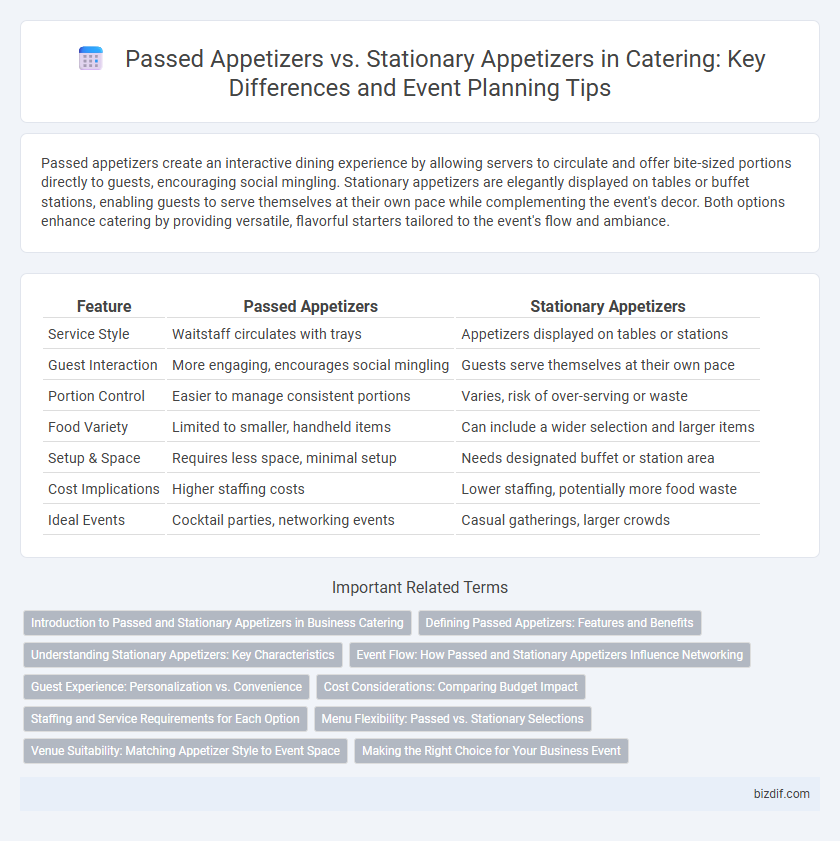Passed appetizers create an interactive dining experience by allowing servers to circulate and offer bite-sized portions directly to guests, encouraging social mingling. Stationary appetizers are elegantly displayed on tables or buffet stations, enabling guests to serve themselves at their own pace while complementing the event's decor. Both options enhance catering by providing versatile, flavorful starters tailored to the event's flow and ambiance.
Table of Comparison
| Feature | Passed Appetizers | Stationary Appetizers |
|---|---|---|
| Service Style | Waitstaff circulates with trays | Appetizers displayed on tables or stations |
| Guest Interaction | More engaging, encourages social mingling | Guests serve themselves at their own pace |
| Portion Control | Easier to manage consistent portions | Varies, risk of over-serving or waste |
| Food Variety | Limited to smaller, handheld items | Can include a wider selection and larger items |
| Setup & Space | Requires less space, minimal setup | Needs designated buffet or station area |
| Cost Implications | Higher staffing costs | Lower staffing, potentially more food waste |
| Ideal Events | Cocktail parties, networking events | Casual gatherings, larger crowds |
Introduction to Passed and Stationary Appetizers in Business Catering
Passed appetizers, also known as butler-style appetizers, are served by catering staff who circulate among guests, offering small, bite-sized portions that encourage mingling and social interaction. Stationary appetizers are displayed on platters at designated tables or stations, allowing guests to serve themselves at their convenience, which is ideal for larger events with high foot traffic. Choosing between passed and stationary appetizers depends on event format, guest dynamics, and service style preferences to enhance the overall catering experience.
Defining Passed Appetizers: Features and Benefits
Passed appetizers are bite-sized, handheld dishes served by catering staff directly to guests, promoting social interaction and minimizing wait times. These appetizers enhance event flow by allowing guests to mingle freely without gathering around a stationary food display. Their strategic presentation increases guest satisfaction through easy access and continuous refreshment.
Understanding Stationary Appetizers: Key Characteristics
Stationary appetizers in catering are displayed on tables or buffets, allowing guests to serve themselves at their convenience, which encourages mingling and a relaxed atmosphere. These appetizers typically consist of bite-sized portions that maintain their quality without refrigeration, such as cheese platters, charcuterie boards, and vegetable crudites with dips. Unlike passed appetizers, stationary options reduce staffing needs and facilitate a more casual dining experience.
Event Flow: How Passed and Stationary Appetizers Influence Networking
Passed appetizers encourage movement and interaction by prompting guests to circulate and engage with one another, enhancing networking opportunities during events. Stationary appetizers create designated areas for guests to gather, fostering more focused conversations in smaller groups. Balancing passed and stationary options optimizes event flow, catering to diverse social preferences and maximizing attendee engagement.
Guest Experience: Personalization vs. Convenience
Passed appetizers enhance guest experience by offering personalized service through direct interaction with servers, allowing guests to select items at their pace and creating a dynamic social atmosphere. Stationary appetizers prioritize convenience and accessibility, enabling guests to serve themselves at their leisure, which suits larger gatherings and encourages casual mingling. Balancing personalization and convenience depends on event size, style, and guest preferences for an optimal catering experience.
Cost Considerations: Comparing Budget Impact
Passed appetizers typically incur higher costs due to the need for additional staff to serve guests and the complexity of presentation, increasing labor expenses. Stationary appetizers reduce labor demands by allowing guests to serve themselves, resulting in lower staffing costs and often simpler, bulk preparation methods. Evaluating budget impact requires balancing the interactive experience of passed appetizers against the cost-efficiency of stationary setups in catering event planning.
Staffing and Service Requirements for Each Option
Passed appetizers require more staff to efficiently circulate trays among guests, ensuring quick service and maintaining food quality, while stationary appetizers typically need fewer attendants, as guests serve themselves from designated tables or stations. Staffing for passed appetizers demands trained servers adept at balancing multiple trays and navigating crowded spaces, enhancing guest interaction and timely replenishment. Stationary setups ease service pressure but require strategic positioning of staff to monitor food levels and maintain cleanliness, optimizing guest experience with minimal direct engagement.
Menu Flexibility: Passed vs. Stationary Selections
Passed appetizers offer dynamic menu flexibility by allowing caterers to showcase a rotating variety of bite-sized options tailored to guest preferences and event themes. Stationary appetizers provide consistent availability and presentation, ideal for guests to select at their own pace but often limit menu variation due to space constraints. Choosing between passed and stationary appetizers depends on desired guest interaction and the level of customization in menu offerings.
Venue Suitability: Matching Appetizer Style to Event Space
Passed appetizers enhance guest interaction in open, dynamic venues by encouraging movement and socializing, making them ideal for cocktail parties and networking events. Stationary appetizers suit formal or seated settings with limited space, providing easy access to food without disrupting the flow of the event. Selecting the appetizer style based on venue size and layout optimizes guest experience and operational efficiency.
Making the Right Choice for Your Business Event
Passed appetizers create a dynamic atmosphere by encouraging guest interaction and seamless movement, ideal for networking-focused business events. Stationary appetizers offer a more relaxed, elegant setup perfect for formal gatherings where guests remain seated, enhancing the dining experience. Choosing between passed and stationary appetizers depends on the event's flow, guest engagement goals, and space logistics to maximize attendee satisfaction.
Passed appetizers vs stationary appetizers Infographic

 bizdif.com
bizdif.com